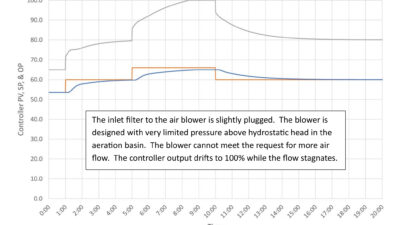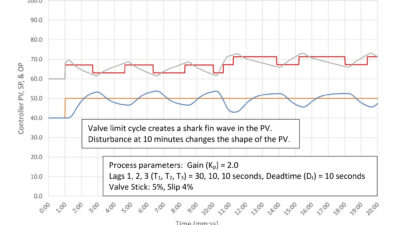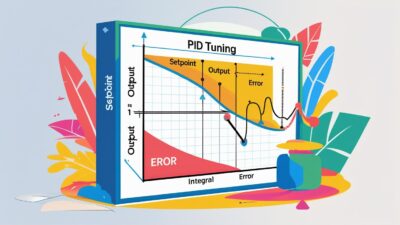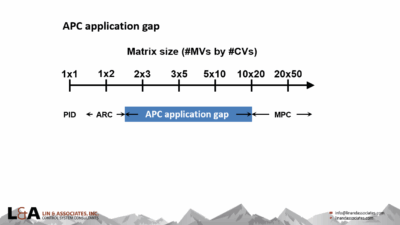Previous articles in this series have discussed how best to achieve a set of control objectives. Specifying those objectives has not been an issue. This article discusses creating and integrating a process optimization function with process control functions. The ultimate goal: move the process from current operating objective to a more profitable one.
Related reading Latest Control Engineering articles in the Control Methods series include:
Model Predictive Controller
Model-based Reactor Control
Advanced Process Control: Fuzzy Logic and Expert Systems
AT A GLANCE
Calculate optimization benefits
Locate optimal conditions
Integrating control, optimization
Operator impact
Previous articles in this series have discussed how best to achieve a set of control objectives. Specifying those objectives has not been an issue. This article discusses creating and integrating a process optimization function with process control functions. The ultimate goal: move the process from current operating objective to a more profitable one.
Both historically and academically, control engineers typically have been more concerned about control performance than economic performance. Control system performance measures in common use reflect this focus. Integrated error (IE), damping ratio, and the index used in this series, integrated squared error (ISE), are all examples of this kind of index. Many others have been proposed and used.
Nonetheless, in industry the bottom line is always economic. Designing, installing, and commissioning control strategies represent an investment in time and money. As such, a control improvement project must compete with many other worthy candidates for both its company’s and its plant’s capital-and-engineering resources. If a better control strategy can’t demonstrate increased revenue and/or reduced costs for the plant, it simply isn’t going to be implemented.
However, when the economic benefit from applying an advanced control strategy can be strongly justified, not implementing the strategy is simply watching money flow out the door. Doing nothing is not free; a penny not gained is a penny lost. In plant accounting it is completely appropriate to consider a control strategy as an economic entity, separate from the control hardware in which it is implemented. A control strategy generating a continuing stream of benefits is a non-depreciating asset that will never wear out and which should be applied to its maximum economic advantage.
Calculate optimization benefits
Certainly, there can be real benefits from improving control around current operating conditions. Primary benefits include:
Minimizing oscillations creating mechanical wear, thermal stresses, and variations in efficiency, yield, and product quality;
Preventing or minimizing disturbances between units;
Reducing shift-to-shift variations by different operators; and
Reducing operator attention necessary for problem loops or alarm conditions.
These economic benefits fall into the category of cost avoidance. When improved control avoids emissions penalties, maintains safe operating conditions, minimizes damage to equipment, and reduces off-specification product, significant expenses can be avoided—though they are usually difficult to quantify and prove.
Cost avoidance is only part of the benefit picture; the rest is increasing return. The basic profit gained from operating a unit, such as the economic return (without indirect factors like overhead and depreciation), is the difference between the value of its product and the cost of the materials and energy it consumes. The most valuable contribution from advanced control is the opportunity it provides for moving the process to an operating point where these factors are more favorable.
Improved control allows a shift in operating point.
Figure 1 shows the concept, illustrating several frequency distributions for a variable under automatic control. Distribution 1 shows the initial distribution for variation of the control variable (CV) around its setpoint, [CE style is setpoint] a nominal value of 1.0. Standard deviation of this distribution is 0.2. Most values are at or near the setpoint. Only a very small percentage of the readings are more than 3.0 standard deviations above setpoint, that is beyond a value of 1.6. If the distribution is normal, this percentage will be 0.14%. Placing the setpoint for this CV 3 standard deviations from its specification limit means that very little of this product will be out of specification.
Distribution 2 shows the distribution after applying a control system that reduces standard deviation of this CV variation by half. Control at the same setpoint is much tighter and there are virtually no out-of-specification values.
Distribution 3 shows the distribution after subsequently shifting the CV setpoint closer to the specification limit by an amount equal to the original standard deviation, 0.2 units. The percentage of out-of-specification values is still very small, even less than in the original distribution.
In effect, improved control has allowed shifting the setpoint closer to the quality specification limit without increasing the amount of out-of-specification product. If this setpoint shift provides an economic benefit, credit can be claimed by the control system that reduced the original variation by half.
Figure 1 is conceptual. In practice, CV variations are never normal, and it is typically more difficult to control closer to constraints because, at the constraints:
Process gains may be higher;
MV changes may be limited; and
Non-linearities may be more dramatic.
The concept remains. A control system can claim credit for the incremental economic benefit its operation creates.
Potential benefits of improved control fall into several categories, including:
Higher production rate and/or product value;
Lower raw-material feed rate (higher yield); and
Lower energy consumption per unit-of-production (higher efficiency).
Where unit production is constrained by market demand or some other plant unit, a benefit may still exist from reducing run time at higher production rates. Additional benefits may include longer catalyst life or reduced fouling. Every situation is unique.
A simple set of before-and-after expressions quantifies major benefits. For production rate and product value, the benefit can be calculated as:
(PR new x RT new x PV new ) – (PR old x RT old x PV old )
where:
PR = production rate, unit/time
RT = run time
PV = product value, $/unit
Similarly, for feed rate and feed value:
(FR old x RT old x FC old ) – (FR new x RT new x FC new )
where:
FR = feed rate, unit/time
FC = feed unit cost, $/unit
And finally, for energy efficiency and energy cost:
(PR old x EE old x RT old x EC old ) – (PR old x EE old x RT old x EC old )
where:
EE = energy efficiency, such as energyrequired/unit-of-product
EC = energy cost, $/unit
Each of these expressions yields a difference in operating profit between two steady-state operating conditions over some period of time. Often, a control system provides benefits of each kind. The total benefit is the sum of all three.
Find optimum conditions
The objective of process optimization is to identify the operating point for a process that will generate the maximum economic return. Even if the optimum is known in general terms, such as maximum production rate, it is still necessary to identify specific values as controller objectives.
Every steady-state operating point is defined by a set of operating conditions, such as a set of values for the CVs, MVs, and FVs. The process itself relates these values to each other. In the reactor, for example, a set of MV values for the ingredient and steam flows, combined with the current values for ingredient temperatures and other unmeasured conditions, will cause a specific set of values for the CVs—production rate, product composition, and product temperature.
This set of values is termed ‘consistent’—they go with each other. Change one of the input MVs or FVs and the CV values also will change. To get to another set of CV conditions, one or more of the MVs must also change.
The search for the optimum steady-state conditions examines a bounded operating space. Boundaries are a set of user-specified upper and lower constraints for CVs and MVs. Within this space, an optimizer uses the process model to relate values of the CVs and MVs to each other, and applies ‘cost factors’ to compute a ‘profit function’ across the bounded space. The point having the highest ‘profit’ is the optimum operating condition.
The optimization algorithm uses positive factors for variables that create an economic gain, such as production rate. It uses negative factors for variables that create an economic cost, such as energy usage. Cost factors are set to zero for variables that have no economic consequence, such as inventory variables.
As with process models, optimizers can be either linear (LP) or non-linear (NLP). A linear optimizer uses constant process gains and cost factors throughout the space. A non-linear optimizer can accommodate cost factors and process gains that vary with operating point.
There is nothing in the concept of an optimizer requiring it to be either linear or non-linear. However, mathematics of linear optimizers are much simpler, and have one very important property—the optimum operating point always will lie at the intersection of two or more constraints. This is usually consistent with the reality of process operations. Typically, production should be pushed ever higher, or impurity increased, or energy usage pushed ever lower, until some physical or operational constraint is reached.
Exceptions occur when values or costs are not constant—for example, when:
Product market value varies with its purity;
Market value of a product falls when production exceeds demand;
Feed material cost increases with its consumption; and
Energy input cost increases with its consumption.
In such cases, finding the optimum requires using a non-linear optimizer and accurately specifying how the factors vary with operating point. In these cases, the optimum point can lie anywhere within the bounded space and typically will not be at a constraint. But when these factors are constant, or vary so slightly that they can be considered constant, a linear optimizer is appropriate. In this case it is not necessary to know exact values of the cost factors. Specifying the proper signs and relative magnitudes is enough to locate the constrained optimum conditions.
Integrate control, optimization
Once the optimum is located, the next step is transferring it to the controller as a set of control objectives. CV values are written (to a model predictive controller, MPC) as setpoints for those variables under setpoint control, while CVs under constraint control continue to be held within constraints but at no specific value. MV values are written as MV targets pursued by the controller according to the target weights. Total number of objectives cannot exceed the number of degrees of freedom in the controller.
An optimizer can affect the controller’s dynamic performance in two ways—by its relative interval of execution and through the target weights assigned to MV targets.
Execution interval of the optimizer must be equal to or longer than the interval of the controller. Normally, optimization interval should be several times the control interval. If the optimizer changes controller objectives too often or too much, the controller will never settle. For this reason, optimizers generally also include a filter to gradually transfer new targets to the controller. Similarly, reducing the target weights for MVs will dampen the effect of the optimizer on the controller.
Constraints specified in the optimizer must be compatible with constraints specified in the controller. Constraints for the optimizer should be set slightly within the constraints in the controller to allow for variation around the optimum setpoints.
Sometimes, especially if CV and MV boundaries in the optimizer are improperly set, the optimizer will be unable to find a consistent optimum within the specified bounds, so a solution is ‘infeasible.’ Generally, this is handled by using importance factors to relax some of the CV constraints until a solution can be found. MV constraints are never relaxed.
Reactor optimizer performance
To illustrate optimizer performance, a linear optimizer was configured to work with the MPC discussed in the previous article. The optimizer uses steady- state gains from the same process model used by the controller.
For the reactor, the cost factors are constant and the economic incentives are clear.
Minimize the amount of the most expensive ingredient in the product, such as lowering the product composition setpoint as close to its specification limit of 75% of A as the quality of composition control will allow;
Lower the temperature setpoint as close to the specification limit of 120oF as the quality of temperature control will allow to minimize energy consumption; and
Make as much of the product as possible, subject to availability of feed and energy.
Figure 2 shows trends for the CVs and MVs before and after the optimizer comes into operation. The first section shows MPC controller performance for a composition setpoint change. After the dead time, composition moves rapidly to the new target with minimal overshoot and rapid settling. At the same time, the MPC controller keeps the temperature essentially constant; it varies by less than 0.5oF.
This performance indicates a reasonable buffer between the MPC and LP constraints. The LP is configured to allow a composition setpoint as low as 75.5% of A and a temperature setpoint as low as 120.5oF.
After the optimizer becomes active, it quickly lowers product composition and temperature setpoints to their LP low constraints. Actual product composition follows approximately 1 dead time behind. Temperature also follows with a slight undershoot. The LP also begins gradually increasing production rate. Steam flow falls initially because of the lower temperature setpoint and then increases with production. The LP continues increasing production setpoint until reaching the upper LP high constraint for ingredient A, set at 140 gpm. While production is increasing, the MPC controller maintains composition and temperature at setpoint.
This example optimization provides significant economic benefit compared to the original conditions. With original conditions, the profit generated by this unit was the difference between the value of the product and the cost of feed and energy:
P old = (100 gpm x $1.25/gal) – (80 gpm x $0.40/gal) – (20 gpm x $0.10/gal) – (20,000 lb/hr x 1 hr/60 min x $4.50/1,000-lb) = 89.50 $/min)
After optimization, the new profit is:
P new = (185.3 gpm x $1.25/gal) – (140 gpm x $0.40/gal) – (45.4 gpm x $0.10/gal)
– (29, 500 lb/hr x 1 hr/60 min x $4.50/1,000-lb) = 168.87 $/min
Over the course of a year, this adds up to a very significant figure:
P yr = (168.87 – 89.5) $/min x 60 min/hr x 24 hr/day x 350 day/yr = $40,002,480 / yr
In the first article in this series, the benefit gained from controlling the reactor to composition and temperature specifications at the same production rate was calculated at $926,213/yr. This simple example indicates how even marginal benefits from optimization can create very significant returns over time, especially when they include increased production.
This example also demonstrates the most fundamental and beneficial reason for implementing advanced control schemes. Applying advanced control systems in industrial plants as an end in itself is usually not economically justified. Their major contribution is the opportunity they create for driving the process to a point where control is more difficult but also more profitable.
Operator impact
Implementing an optimizer over a process controller takes the operator one step farther from minute-to-minute process oversight. It creates many of the same operational issues as the advanced controls already discussed, only more so.
Turning over the responsibility of fixing controller objectives to an optimizer elevates operators to an even more strategic operational role. The challenge for an operator becomes identifying and setting proper values for the constraints, which bound the operational and optimization space.
Furthermore, as the optimizer pushes against constraints, the operator becomes responsible for validating the current constraint settings and identifying opportunities for relieving conditions that are limiting economic performance of the unit.
This is not an easy job. Success requires involving operators from the very beginning of the project and fully training them on operation of and reasoning underlying the optimizer, their role in managing its operation, and the benefits they create. Good operators will feel empowered and enthusiastic about the challenge.
Next stage
With the implementation of an integrated controller and optimizer, commissioning an advanced control strategy is complete. But it is still necessary to prove that the strategy can deliver and sustain the projected benefits that provided the original justification. Proving control system performance is the subject of the next article in this series.
Author Information
Lew Gordon is a principal application engineer at Invensys;



